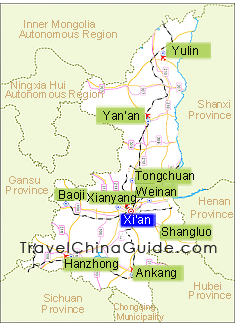- CURRENT LOCATION: HOME
- >> Tourism
- >> Travel Tips
- >>
- Traveling
Xi’an Travel Guide
2017-12-14 10:21:11 , Source : The Government Website of Shaanxi ProvinceXi’an, located in central-northwest China, records the great changes of the country just like a living history book. Called Chang’an (meaning the eternal city) in ancient times, it is one of the birthplaces of the ancient Chinese civilization in the Yellow River Basin area. As the eastern terminal of the Silk Road and the site of the famous Terracotta Warriors of the Qin Dynasty, the city has won a reputation all over the world. More than 3,000 years of history including over 1,100 years as the capital city of ancient dynasties, have endowed the city with an amazing historical heritage. Travelers marvel at the numerous historical sites and cultural relics in the city.
Read more about Xi’an History.
Known as the leading city of China’s Western Development Drive Program since 1990s, Xi’an is an important economic, cultural, industrial and educational center of the central-northwest region, providing visitors with modern and convenient facilities.
Xi’an Facts

English Name: Xi’an, Hsian, Sian
Chinese Name: 西安 (xī ān)
Alias: Chang’an
Location: Guanzhong Plain, Shaanxi Province, Northwest China (34°16′N, 108°54′E)
Postal Code: 710000 - 710090
Area Code: 029
Were China a tree, Beijing would be the crown while Xi’an would be its deep roots. As a saying goes: “Go to Shanghai and you will find a 100-year-old China; go to Beijing and you will find a 1000-year-old China; go to Xi’an and then you will find a 3000-year-old China.” Xi’an, the cradle of China, is, by any means, on your China travel list.
Historically known as Chang’an, it was home to the ruling house of 13 dynasties, notably, the Qin (221 BC – 207 BC), Han (206 BC – 220 AD), Sui (581 AD – 618 AD) and Tang (618AD – 908AD) Dynasties. The Emperor Qin Shihuang united China for the first time and left Xi’an and the world one of the most extraordinary archeological finds in history - the Terracotta Warriors, which attracts hundreds of thousands of visitors a year. The city reached its peak in the Tang dynasty, boasting 2 million taxable inhabitants and the largest, most cosmopolitan, settlement in the world during the reign of Xuanzong (712 AD – 756 AD).
Together with Athens, Cairo and Rome, Xi’an is among the four major ancient civilization capitals of the world. It is on the natural westward land route out of China into Central Asia, the starting point and terminus of the Silk Road, which brought the city material wealth as well as religious and cultural melting for over a thousand years.
Surviving monuments open a window to this ancient city. The short-lived totalitarian state of Qin Shihuang is mirrored in the awe-inspiring massed terra-cotta armies of the Terracotta Warriors. The influence of Buddhism is clear from the Wild Goose Pagoda, a chamber for the translation of the Buddhist scriptures by then widely renowned Master Xuan Zang, who returned to China in 645 after 15 years of travel across India and central Asia. Evidence of the flourishing trade along the Silk Routes may be found in the Shaanxi History Museum and Famen Temple. Another reminder of the enduring legacy of the Silk Road is the Great Mosque of Xi’an, presenting a strong Muslim minority, whose faith remains unchanged although their architecture is a mixture of Chinese design and western Islamic tradition.
Today, despite the searing summer heat and freezing winters, Xi’an is a joy to visit. The central city is pleasantly compact and its grid layout within the city wall makes it easy to navigate. The Bell Tower is the geographical center of the city, from which four main business streets radiating, North Avenue, South Avenue, West Avenue and East Avenue. With many universities around, Xiao Zhai is popular with youth and students and thus is one of the busiest commercial areas. The ancient streets of Shuyuanmen and Luomashi commercial area are two must-visit places. Actually, sightseeing in and around the city can keep even the most energetic visitors busy for a week or two.
The local cuisine is not among the eight great cuisines of China, but it enjoys enormous popularity. If you visit one of the local cuisine restaurants and taste local favorites like Yang Rou Pao mo, you will find out why. After dinner, you can either enjoy a traditional form of entertainment, like the Qin Opera and the Tang Dynasty Music and Dance Show, or indulge in modern bars and karaoke places.
Feel like shopping? Just go for traditional arts and crafts, folk handicrafts or replicas of antiquities. Xi’an is famous for good imitations of arts and crafts of the Qin and Tang dynasties, such as tri-colored glazed pottery and imitations of ancient bronze ware. Beyond that, visitors can also find replica Qin Dynasty embroidery, artistic porcelain ware, jade, carvings, paper cuttings, and paintings by the farmers of Huxian County which features strong Chinese traditions and local characteristics.
Locals are easygoing, yet shake their heads in regret that their ancestors “fell behind” their richer cousins in Beijing. However, tens of thousands of worldwide visitors, together with plenty of upscale new malls full of well-dressed shoppers, tell you that Xi’an is not that far behind.
Transportation
Xi’an is one of the most important and convenient transportation hubs in central and western China. Frequent flights, trains and buses connect the city with other major cities all around the country. The urban transportation of the city has been somewhat frustrating in recent years because of the metro construction. Now metro line 1, line 2 and line 3 are in operation. Several other lines are also under construction or in the planning process. For now the buses and taxis can take you to get around the city.
Airport
Train
Long-Distance Bus
City-Bus
Bicycle
Metro
Taxia

Government Organizations



Other Links

Copyright@www.shaanxi.gov.cn All Rights Reserved
Registration Number:陕ICP备10004160号
